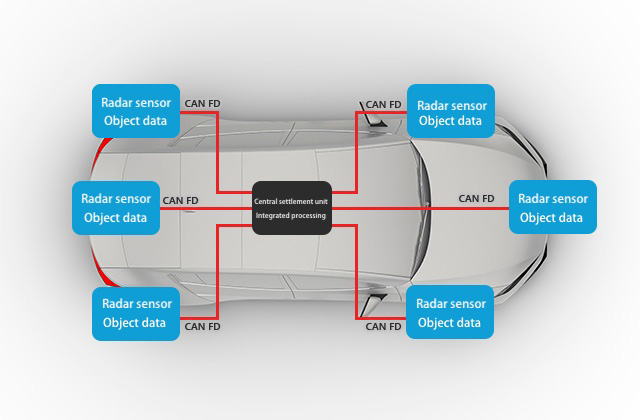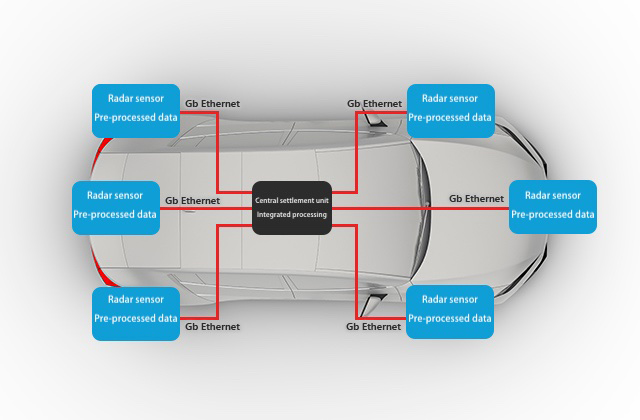
- NXP Semiconductors N.V.
- NEXT Mobility
- ICT and Industrial
- Smart Factories and Robotics
Automotive millimeter-wave radar is an important sensor playing a crucial role in Advanced Driver Assistance Systems (ADAS) and autonomous driving technology. It uses radio waves ranging from 24GHz to 77GHz to detect the distance, velocity, and angle of objects around the vehicle with high accuracy, demonstrating reliable object detection performance even in bad weather or darkness.
This page provides an overview of automotive millimeter-wave radar and introduces the advanced radar product family from NXP, a leader in the automotive millimeter-wave radar market.
What is Automotive Millimeter-Wave Radar?
Automotive Millimeter-Wave Radar, an Important Sensor in ADAS and Autonomous Driving Technology
Automotive millimeter-wave radar is an important sensor playing a crucial role in Advanced Driver Assistance Systems (ADAS) and autonomous driving technology.
This radar utilizes radio waves within the 24GHz to 77GHz frequency band to detect the distance, velocity, and angle of objects with high precision. By applying this technology, automotive millimeter wave radar accurately identifies objects such as obstacles, people, and other vehicles located in front of or around the vehicle. This technology offers reliable performance even in adverse weather conditions or darkness and possesses superior environmental adaptability compared to other automotive sensors such as cameras or LiDAR. It also combines low cost with excellent durability, making it suitable for a wide range of applications from passenger vehicles to commercial vehicles.
Current primary applications are focused on ADAS areas such as forward collision warning (FCW), automatic emergency braking (AEB), adaptive cruise control (ACC), lane change assist (LCA), and blind spot detection (BSD).
Millimeter-wave radar is considered an essential element in the future development of autonomous driving technology, and efforts continue to improve object recognition performance, enhance real-time processing capabilities, and reduce costs.

Advancements in Automotive Millimeter Wave Radar: Higher Resolution, Cost Reduction, and Integration
Technology trends in automotive millimeter wave radar are primarily moving towards higher resolution, cost reduction, and integration.
Higher resolution enables more detailed recognition of the vehicle's surrounding environment, improving the detection accuracy of vehicles, pedestrians, and obstacles. This enhances vehicle safety and enables responses to complex traffic situations.
Achieving autonomous driving requires installing numerous sensors to recognize the surrounding environment. Reducing the cost of these sensor systems is a crucial point in promoting the adoption of autonomous driving. Semiconductor manufacturers producing millimeter wave radar chips are developing products that integrate components such as radar transmit and receive functions, high-frequency analog circuits, ADCs, signal processing DSPs, and processors onto a single chip. Integrating millimeter wave radar functions onto a single chip reduces the system implementation area, enabling miniaturization of millimeter wave modules. Also, because processing from the high-frequency front end to final processing can be handled seamlessly within the package, radar system development costs can be reduced. This seamless integration of processing, from the high-frequency front end to final processing, reduces complexity and contributes to lower radar system development costs.
As a crucial technology for enhancing vehicle safety and convenience, we can expect automotive millimeter wave radar to continue to evolve.

Automotive Millimeter Wave Radar Architecture: Moving from Edge to Distributed Radar
Automotive millimeter wave radar has two types of architectures: edge radar and distributed radar.
Each of these types is described below.
Edge Radar Architecture
With this architecture, radar sensor modules are placed in various locations on the vehicle. In edge radar, each module independently handles tasks like object clustering (grouping) and tracking, sending only object-level data to the central processing unit. An advantage of edge radar is the reduction in data traffic between the sensor modules and the central processing unit. However, this approach increases costs because individual radar sensors require features such as high-performance CPUs and dedicated signal processing DSPs (SPT: Signal Processing Toolbox). Additionally, the central processing unit must integrate the object data received from each sensor.

Edge Radar Architecture
Distributed Radar Architecture
With this architecture, radar sensor modules are placed in various locations on the vehicle. In distributed radar (distributed cooperative type), individual radar sensors do not perform processing. Instead, preprocessed data is gathered from the sensors by the central processing unit for collective processing. Because all sensor data is processed together in the central processing unit, distributed radar allows for efficient signal processing and enhances the safety of ADAS functions. Costs can also be reduced because individual sensors do not require features such as high-performance CPUs or signal processing DSPs (SPT). By collectively processing the preprocessed data received from individual sensors, the central processing unit achieves low latency and improves both resolution and object recognition performance. However, this method increases the volume of communication data, as sensors send large amounts of preprocessed data to the central processing unit. This necessitates high-speed data communication interfaces, such as Gigabit Ethernet, capable of managing the increased data traffic between the sensors and the central processing unit. For this reason, the central processing unit requires extremely high processing power to handle the vast amounts of data simultaneously.

Distributed Radar Architecture
Today, edge radar is the predominant architecture for automotive millimeter wave radar systems.
Semiconductor manufacturers are currently advancing the development of products like single-chip radar ICs and high-performance, radar specific processors compatible with Gigabit Ethernet. As these radar chipset technologies evolve, it is anticipated that future automotive millimeter wave radar architectures will shift towards distributed systems.
- Reference
NXP's Automotive Millimeter-Wave Radar Products
NXP has long provided advanced products in the automotive millimeter wave radar field. As a leading semiconductor manufacturer in the automotive radar market, NXP offers a portfolio of MMIC, processor, and radar SoC product families that excel in integration, safety, and security.
The RFCMOS Radar SoC supports both edge radar and distributed radar architectures.

RFCMOS Radar SoC
The RFCMOS Radar SoC is a highly integrated single-chip radar system produced using RFCMOS (Radio Frequency Complementary Metal Oxide Semiconductor) technology. It combines an RF front end and a multicore radar processor into a single device.
The RFCMOS Radar SoC supports both edge radar and distributed radar architectures.
SAF85xx: high-performance 77 GHz RFCMOS automotive radar single chip SoC [under development]
The SAF85xx is a radar sensor compatible with centralized radar architectures.
It integrates essential functions for radar processing onto one chip, including the RF front end, a multicore processor, and an SPT (radar signal processing DSP).
Compared to NXP's previous generation products, the SAF85xx delivers double the RF performance and achieves up to 40% faster radar signal processing.
The SAF85xx RFCMOS automotive radar system on chip (SoC) is a high-performance single-chip product for automotive FMCW radar applications, optimized for fast chirp modulation. (excerpt) "...this 3rd generation RFCMOS radar device supports short, mid, and long-range radar applications in a small form factor, enabling everything from entry-level NCAP sensors to high-performance front radar sensors.
This fully integrated RFCMOS chip includes four transmitters, four receivers, ADC conversion, phase rotators, a low phase noise VCO, SPT radar accelerator, BBE32 Vector DSP, Arm Cortex A53, Arm Cortex M7 cores, and SRAM. It supports a wide range of applications and various radar data outputs, such as object data, point cloud data, and FFT output."

SAF85xx Block Diagram
Source:
Programs are stored in external flash memory. It is equipped with two CAN FD channels and one Gigabit Ethernet channel for external communication.
For more detailed information, please visit NXP's official website: High-Performance 77 GHz RFCMOS Automotive Radar Single-Chip SoC.
Functional Comparison of SAF85xx and SAF86xx
| Product family | S32R45 | S32R41 |
|---|---|---|
| Frequency band | 76~81 GHz | 76~81 GHz |
| Bandwidth |
|
|
| CPU |
| Arm® Cortex®-M7 (320 MHz) |
| Radar processing acceleration |
| BBE32 Vector DSP |
| Onboard Memory |
| 2MB SRAM with ECC |
| Package |
| 11.95 mm x 14.00 mm LiP (Launcher-in-Package) package variant available |
| Interface |
|
|
| Security |
|
|
| Functional safety |
|
|
| Automotive quality | AEC-Q100 | AEC-Q100 |
| Operating temperature range | -40~150°C (Tj) | -40~150°C (Tj) |
S32R Radar Processor
The S32R Radar Processor is a high-performance processor designed for automotive radar applications. It combines technologies for functional safety and security with high-performance processing cores and dedicated radar signal processing accelerators. It is ideal for applications such as corner radar, front radar, and 4D imaging radar.
The S32R Radar Processor integrates high-performance Arm Cortex CPUs and dedicated accelerators to speed up radar signal processing. This enables high-resolution radar imaging and real time data processing. In addition to supporting CAN FD, which is common in current edge radar systems, its communication interface also supports Gigabit Ethernet. This enables the reception of large amounts of raw data from multiple radar modules in future distributed radar architectures.
When combined with NXP's RFCMOS radar SoC and MMIC products, the S32R Radar Processor delivers the high-performance and flexibility needed next generation automotive radar systems. It provides an optimal solution for enhancing both safety and efficiency.
S32R45: High-Performance Processor for Imaging Radar
The S32R45 is a high-performance microprocessor unit (MPU) developed specifically for automotive imaging radar. Its CPU features Arm Cortex A53 cores and Arm Cortex M7 cores. It also includes hardware accelerators like the SPT (Signal Processing Toolbox), the LAX (Linear Algebra Accelerator) for faster linear algebra calculations, and the BBE32 DSP to accelerate complex radar signal processing. These features strongly support the real-time capabilities and higher resolution demanded by next-generation radar systems. The S32R45 is designed for high-resolution front or rear long-range radar sensors mounted on vehicles, significantly enhancing the resolution of imaging radar.

S32R45 Radar MPU Block Diagram
For more detailed information, please visit NXP's official website: S32R45 High-Performance Processor for Imaging Radar.
S32R41: High-Performance Processor for High-Resolution Radar
The S32R45 is a high-performance microprocessor unit (MPU) developed for automotive 77GHz radar applications. Its CPU features Arm Cortex A53 cores and Arm Cortex M7 cores. It also incorporates the SPT (Signal Processing Toolbox) and BBE32 DSP as tools to accelerate complex radar signal processing, strongly supporting the real time performance and higher resolution required by next-generation radar systems. The S32R41 is ideal for high resolution front radar or corner radar sensors mounted on vehicles.

S32R41 Radar MPU Block Diagram
For more detailed information, please visit NXP's official website: S32R41 High-Performance Processor for High-Resolution Radar.
Functional Comparison of S32R45 and S32R41
| Product family | S32R45 | S32R41 |
|---|---|---|
| CPU |
|
|
| Radar processing acceleration |
|
|
| Interface |
|
|
| Memory |
| 8MB SRAM with ECC |
| Security | Hardware Security Engine (HSE) |
|
| Safety | ISO26262 SEooC ASIL B(D) | ISO26262 SEooC ASIL B(D) |
| Automotive quality | AEC-Q100 | AEC-Q100 |
| Operating temperature range | -40~150°C (Tj) | -40~150°C (Tj) |
Summary
Automotive millimeter wave radar will continue to evolve as an important sensor technology for Advanced Driver Assistance Systems (ADAS) and autonomous driving, contributing to improving the safety and comfort of drivers and pedestrians.
This page has provided an overview of automotive millimeter wave radar and introduced NXP's advanced radar product family. Please do not hesitate to contact us at NEXTY Electronics if you have any interest or questions about NXP's radar products.
NOTE: Detailed information regarding NXP's millimeter-wave radar products is restricted from public release. Obtaining detailed information requires signing an NDA (Non-Disclosure Agreement) with NXP.
Related Info
RFCMOS Radar SoC Related Links
-
[Video] 4D Radar Sensing Realized by SAF85xx Single-Chip Radar SoC
S32R Radar Processor Related Links
-
[Video] Innovation in Automotive Radar Technology for Next-Generation ADAS and Autonomous Driving
-
[Video] Automotive 4D Imaging Radar Demo (Produced by NXP Semiconductors)
-
[Video] The Zero-Accident Future That Will Be Realized by 4D Imaging Radar
-
[Press Release] NXP Ramps Up Production of S32R41 high-performance Radar Processor
Inquiry
Related Product Information

In-Depth Guide to NXP's Automotive PMICs (Page 2/2): Fundamentals and Key Features
This article explains the need for PMICs in automotive ECUs and introduces NXP’s automotive PMIC portfolio and key product features.
- NXP Semiconductors N.V.
- NEXT Mobility

In-Depth Guide to NXP's Automotive PMICs (Page 1/2): Fundamentals and Key Features
This article explains the importance of PMICs in automotive ECUs and introduces the features, advantages, and portfolio of NXP’s automotive PMICs. It covers the basics of PMICs and highlights NXP’s offerings.
- NXP Semiconductors N.V.
- NEXT Mobility

An In-Depth Look at the Advantages of NXP's Automotive Microcontroller S32K1
NXP’s S32K1 automotive microcontroller series features ARM Cortex-M0+ and M4F cores, delivering high performance with low power consumption. This article provides a detailed overview of its benefits and features.
- NXP Semiconductors N.V.
- NEXT Mobility

Introduction to NXP's Automotive General-Purpose Microcontroller Products
NXP’s general-purpose automotive microcontrollers—S32K1, S12 MagniV, and S32K3 families—combine high performance, security, and cost efficiency to support the advancement of automotive technologies.
- NXP Semiconductors N.V.
- NEXT Mobility

NXP Automotive Microcontroller S32K311 Evaluation Board by NEXTY Electronics
The S32K311 is NXP's latest automotive microcontroller that offers high performance and advanced features at a low cost in a compact package. This article introduces its key features and our custom S32K evaluation board.
- NXP Semiconductors N.V.
- NEXT Mobility

Introduction to Edge AI Solutions with NXP's NPU-equipped i.MX/MCX
This article explains the rapidly growing edge AI with real device examples and introduces NXP’s processors and microcontrollers equipped with NPUs.
- NXP Semiconductors N.V.
- NEXT Mobility
- ICT and Industrial
- Smart Factories and Robotics
Link to Related Technical Columns

Building an i.MX development environment (Yocto edition) | Technical column
This article explains how to set up a Yocto development environment using NXP’s i.MX series. It covers hardware, preparation steps, and build procedures, helping you prepare to flash images on i.MX evaluation boards.

Building an i.MX Development Environment (uuu Edition) | Technical Column
This is the second installment of our series of articles on how to build an i.MX development environment. In this column, we will show you how to write the files generated by bitbake to an i.MX evaluation board and perform a simple function check.

How to start creating GUI using GUI Guider | Technical Column
As the use of GUIs grows, high development tool costs have become a challenge. NXP’s free tool, GUI Guider, supports a wide range of GUIs for evaluation boards.





![[Video] The Zero-Accident Future That Will Be Realized by 4D Imaging Radar](https://enexty-assets-public.dxp.nexty-ele.com/nxp/millimeterwaveradar/nxp_millimeterwaveradar_assets16.png)
![[Press Release] NXP Ramps Up Production of S32R41 high-performance Radar Processor](https://enexty-assets-public.dxp.nexty-ele.com/nxp/millimeterwaveradar/nxp_millimeterwaveradar_assets17.jpg)